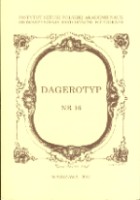Wizja miasta. Warszawa na fotografiach Jana Bułhaka z 1920-1921 roku
The vision of a city. Warsaw on photographs by Jan Bułhak from 1920/1921
Author(s): Danuta JackiewiczSubject(s): Photography
Published by: Instytut Sztuki Polskiej Akademii Nauk
Keywords: Warsaw; Bułhak; Jan; Vilna; The Photographic Archives; photographic publications; photographic exhibition; photography; Polish photography; vintage photography; old photographic technique; Poland; Baroque architecture; Frascati Street
Summary/Abstract: The photographer Jan Bułhak did not consider himself as a cataloguer nor as an archivist who documents reality, but by the majority of people he was recognized as such. The photographs from “The Photographic Archives” made since 1912 for the Municipality of Vilna (under Russian rule at that time), and those taken after World War I in all regions of the reborn Polish state, were referred to by Bułhak as “photographical images”. That is why his series were entitled “Poland in photographical images by Jan Bułhak” and after the World War II “Poland in photographical images by Jan Bułhak and Son”. According to the philosophy of photography that he formulated, he was “depicting knowledge about Poland”. This attitude led him to the introduction of the term of “homeland photography”. During a short stay in Warsaw from July 1920 till April 1921 Jan Bułhak made 716 photographs of the capital city, which in consequence were arranged in thirteen albums numbered from 101 to 113. The only existent copy is kept in the Iconographic Collection of the National Library (Zakład Zbiorow Ikonograficznych Biblioteki Narodowej). The artist photographed his beloved Baroque architecture, as well as places which were not appealing to photographers who permanently lived and worked in Warsaw; for example, buildings and flora along Frascati Street. Bułhak very consequently used the depiction models which he worked out in Vilna that is why so many shots taken in those two cities are hard to distinguish; especially when sculptural details or architectural elements are considered. Warsaw can be easily mistaken for Vilna and vice versa. The purpose of this monographic exhibition of the artist’s oeuvre in the National Museum in Warsaw was, among other things, to restore the memory of Jan Bułhak’s own vision of Warsaw. In the opinion of the article’s author, the symbol of this vision can be seen in the photography Cross from the Jesuit Church and St Martin Church’s tower (Krzyż kościoła Jezuitów i wieża kościoła św. Marcina, ill. 21). This image reminds her of the posterior Vision of the City (Vilna), presented by the photographer since 1930.
Journal: Dagerotyp
- Issue Year: 2007
- Issue No: 16
- Page Range: 67-72
- Page Count: 6
- Language: Polish
- Content File-PDF

